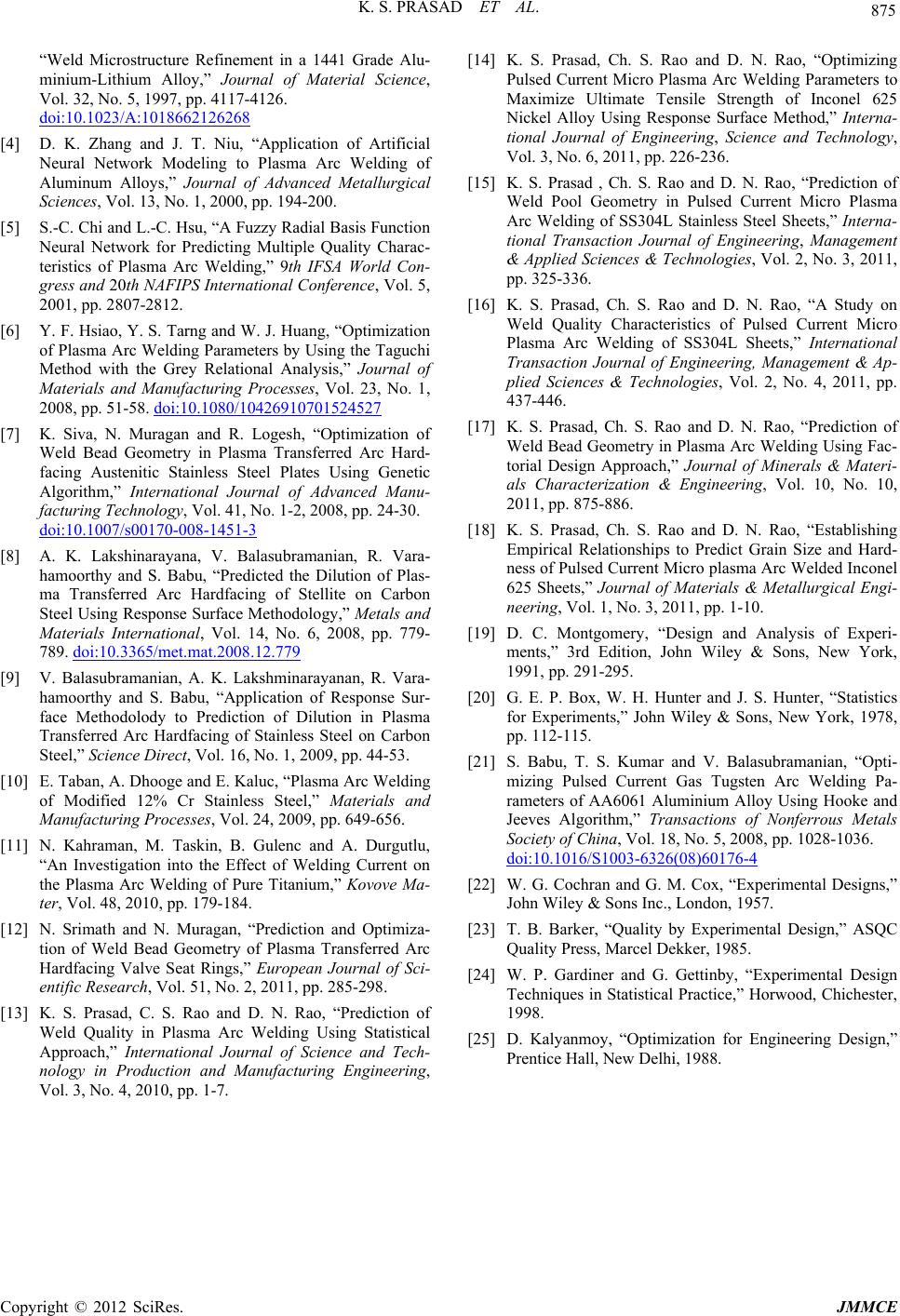
K. S. PRASAD ET AL.
Copyright © 2012 SciRes. JMMCE
875
“Weld Microstructure Refinement in a 1441 Grade Alu-
minium-Lithium Alloy,” Journal of Material Science,
Vol. 32, No. 5, 1997, pp. 4117-4126.
doi:10.1023/A:1018662126268
[4] D. K. Zhang and J. T. Niu, “Application of Artificial
Neural Network Modeling to Plasma Arc Welding of
Aluminum Alloys,” Journal of Advanced Metallurgical
Sciences, Vol. 13, No. 1, 2000, pp. 194-200.
[5] S.-C. Chi and L.-C. Hsu, “A Fuzzy Radial Basis Function
Neural Network for Predicting Multiple Quality Charac-
teristics of Plasma Arc Welding,” 9th IFSA World Con-
gress and 20th NAFIPS International Conference, Vol. 5,
2001, pp. 2807-2812.
[6] Y. F. Hsiao, Y. S. Tarng and W. J. Huang, “Optimization
of Plasma Arc Welding Parameters by Using the Taguchi
Method with the Grey Relational Analysis,” Journal of
Materials and Manufacturing Processes, Vol. 23, No. 1,
2008, pp. 51-58. doi:10.1080/10426910701524527
[7] K. Siva, N. Muragan and R. Logesh, “Optimization of
Weld Bead Geometry in Plasma Transferred Arc Hard-
facing Austenitic Stainless Steel Plates Using Genetic
Algorithm,” International Journal of Advanced Manu-
facturing Technology, Vol. 41, No. 1-2, 2008, pp. 24-30.
doi:10.1007/s00170-008-1451-3
[8] A. K. Lakshinarayana, V. Balasubramanian, R. Vara-
hamoorthy and S. Babu, “Predicted the Dilution of Plas-
ma Transferred Arc Hardfacing of Stellite on Carbon
Steel Using Response Surface Methodology,” Metals and
Materials International, Vol. 14, No. 6, 2008, pp. 779-
789. doi:10.3365/met.mat.2008.12.779
[9] V. Balasubramanian, A. K. Lakshminarayanan, R. Vara-
hamoorthy and S. Babu, “Application of Response Sur-
face Methodolody to Prediction of Dilution in Plasma
Transferred Arc Hardfacing of Stainless Steel on Carbon
Steel,” Science Direct, Vol. 16, No. 1, 2009, pp. 44-53.
[10] E. Taban, A. Dhooge and E. Kaluc, “Plasma Arc Welding
of Modified 12% Cr Stainless Steel,” Materials and
Manufacturing Processes, Vol. 24, 2009, pp. 649-656.
[11] N. Kahraman, M. Taskin, B. Gulenc and A. Durgutlu,
“An Investigation into the Effect of Welding Current on
the Plasma Arc Welding of Pure Titanium,” Kovove Ma-
ter, Vol. 48, 2010, pp. 179-184.
[12] N. Srimath and N. Muragan, “Prediction and Optimiza-
tion of Weld Bead Geometry of Plasma Transferred Arc
Hardfacing Valve Seat Rings,” European Journal of Sci-
entific Research, Vol. 51, No. 2, 2011, pp. 285-298.
[13] K. S. Prasad, C. S. Rao and D. N. Rao, “Prediction of
Weld Quality in Plasma Arc Welding Using Statistical
Approach,” International Journal of Science and Tech-
nology in Production and Manufacturing Engineering,
Vol. 3, No. 4, 2010, pp. 1-7.
[14] K. S. Prasad, Ch. S. Rao and D. N. Rao, “Optimizing
Pulsed Current Micro Plasma Arc Welding Parameters to
Maximize Ultimate Tensile Strength of Inconel 625
Nickel Alloy Using Response Surface Method,” Interna-
tional Journal of Engineering, Science and Technology,
Vol. 3, No. 6, 2011, pp. 226-236.
[15] K. S. Prasad , Ch. S. Rao and D. N. Rao, “Prediction of
Weld Pool Geometry in Pulsed Current Micro Plasma
Arc Welding of SS304L Stainless Steel Sheets,” Interna-
tional Transaction Journal of Engineering, Management
& Applied Sciences & Technologies, Vol. 2, No. 3, 2011,
pp. 325-336.
[16] K. S. Prasad, Ch. S. Rao and D. N. Rao, “A Study on
Weld Quality Characteristics of Pulsed Current Micro
Plasma Arc Welding of SS304L Sheets,” International
Transaction Journal of Engineering, Management & Ap-
plied Sciences & Technologies, Vol. 2, No. 4, 2011, pp.
437-446.
[17] K. S. Prasad, Ch. S. Rao and D. N. Rao, “Prediction of
Weld Bead Geometry in Plasma Arc Welding Using Fac-
torial Design Approach,” Journal of Minerals & Materi-
als Characterization & Engineering, Vol. 10, No. 10,
2011, pp. 875-886.
[18] K. S. Prasad, Ch. S. Rao and D. N. Rao, “Establishing
Empirical Relationships to Predict Grain Size and Hard-
ness of Pulsed Current Micro plasma Arc Welded Inconel
625 Sheets,” Journal of Materials & Metallurgical Engi-
neering, Vol. 1, No. 3, 2011, pp. 1-10.
[19] D. C. Montgomery, “Design and Analysis of Experi-
ments,” 3rd Edition, John Wiley & Sons, New York,
1991, pp. 291-295.
[20] G. E. P. Box, W. H. Hunter and J. S. Hunter, “Statistics
for Experiments,” John Wiley & Sons, New York, 1978,
pp. 112-115.
[21] S. Babu, T. S. Kumar and V. Balasubramanian, “Opti-
mizing Pulsed Current Gas Tugsten Arc Welding Pa-
rameters of AA6061 Aluminium Alloy Using Hooke and
Jeeves Algorithm,” Transactions of Nonferrous Metals
Society of China, Vol. 18, No. 5, 2008, pp. 1028-1036.
doi:10.1016/S1003-6326(08)60176-4
[22] W. G. Cochran and G. M. Cox, “Experimental Designs,”
John Wiley & Sons Inc., London, 1957.
[23] T. B. Barker, “Quality by Experimental Design,” ASQC
Quality Press, Marcel Dekker, 1985.
[24] W. P. Gardiner and G. Gettinby, “Experimental Design
Techniques in Statistical Practice,” Horwood, Chichester,
1998.
[25] D. Kalyanmoy, “Optimization for Engineering Design,”
Prentice Hall, New Delhi, 1988.